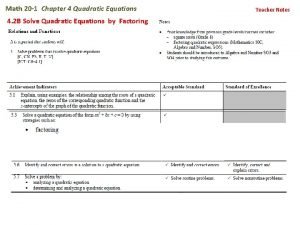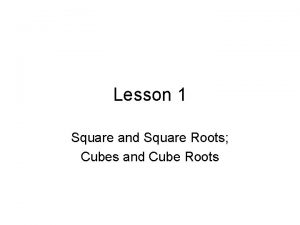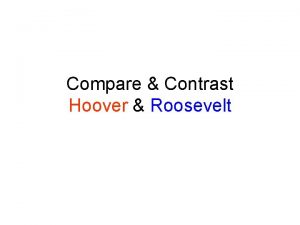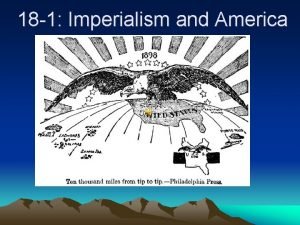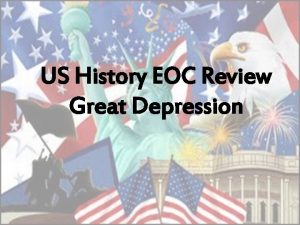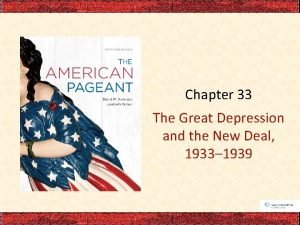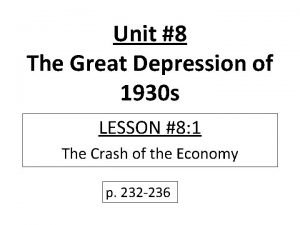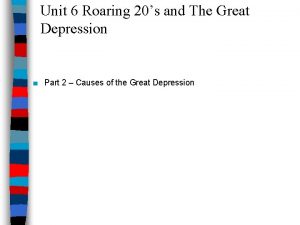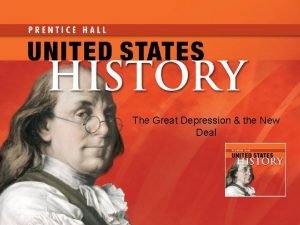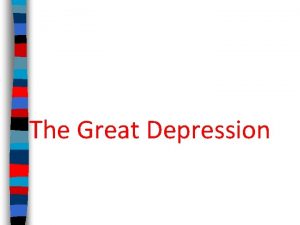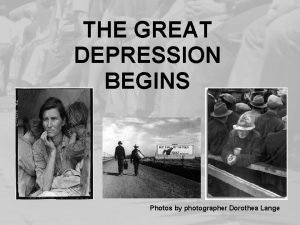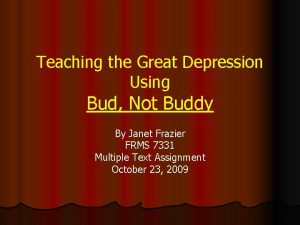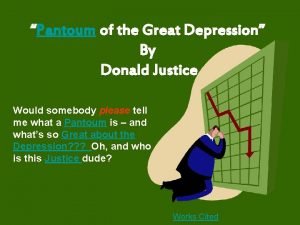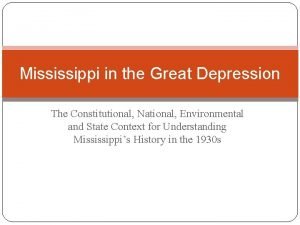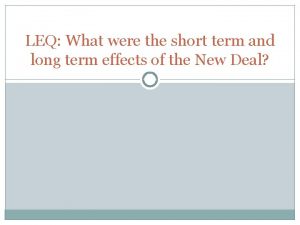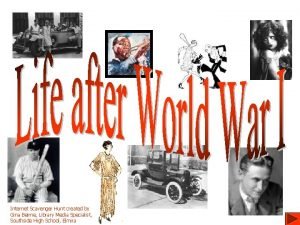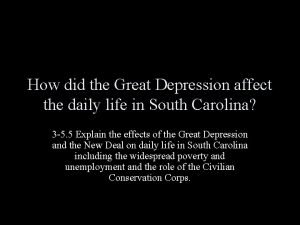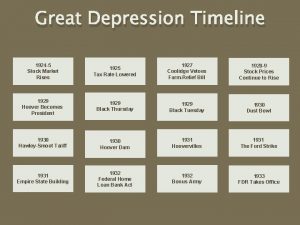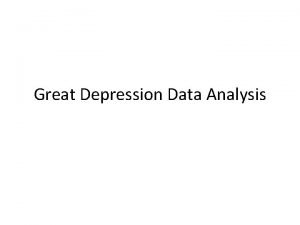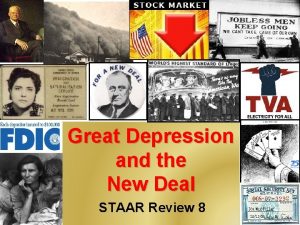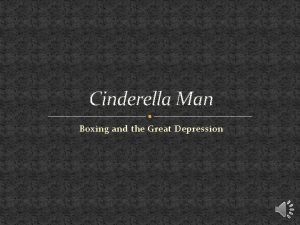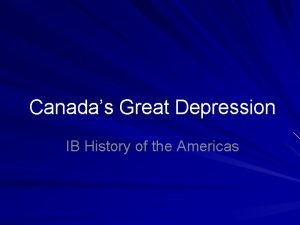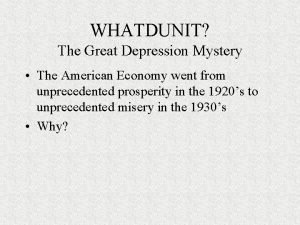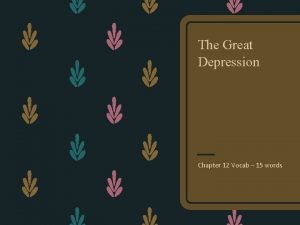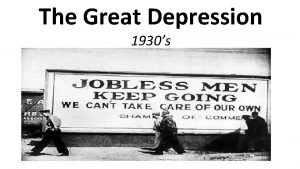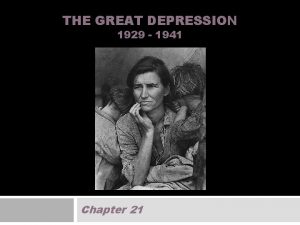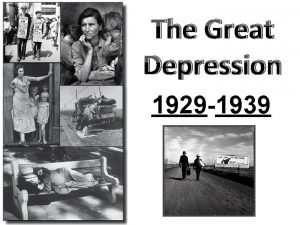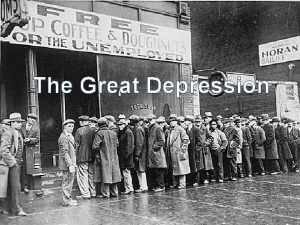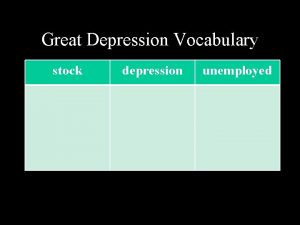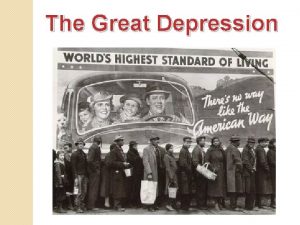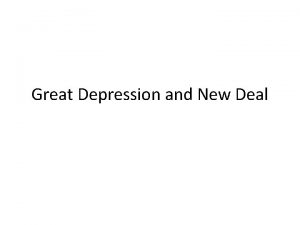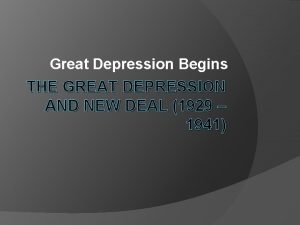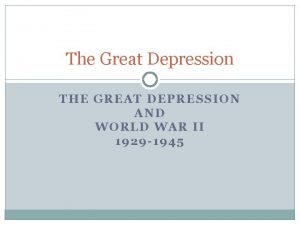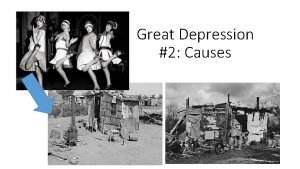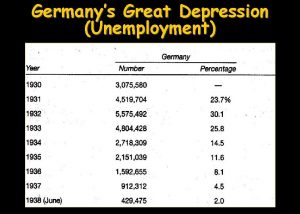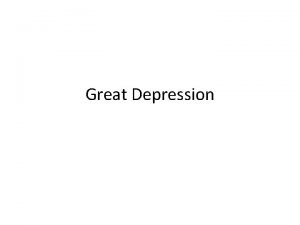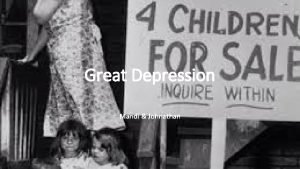Roots of the Great Depression After WWI and








































- Slides: 40

Roots of the Great Depression • After WWI and the devastation caused by the war, U. S. emerges as the world’s leading economic power. It has the world’s biggest economy and is the world’s leading lender. • By 1929, the U. S. was responsible for 42% of the world’s output of goods (Britain, France and Germany TOGETHER produced 28%)

Causes of the Great Depression • What questions do you have on the reading, particularly on the economics? Discuss the reading 8 -10 minutes in table groups; see what you don’t understand. Can you summarize each of the causes in the reading?

The Federal Reserve System, often referred to as the Federal Reserve or simply "the Fed, " is the central bank of the United States. It was created by the Congress to provide the nation with a safer, more flexible, and more stable monetary and financial system. The Federal Reserve was created on December 23, 1913, when President Woodrow Wilson signed the Federal Reserve Act into law. Today, the Federal Reserve's responsibilities fall into four general areas. ● Conducting the nation's monetary policy by influencing money and credit conditions in the economy in pursuit of full employment and stable prices. ● Supervising and regulating banks and other important financial institutions to ensure the safety and soundness of the nation's banking and financial system and to protect the credit rights of consumers. ● Maintaining the stability of the financial system and containing systemic risk that may arise in financial markets. ● Providing certain financial services to the U. S. government, U. S. financial institutions, and foreign official institutions, and playing a major role in operating and overseeing the nation's payments systems.

How did each of these contribute to the Depression? • Stock speculation: buying on margin (borrowing) to buy stocks. Works generally as long as stock prices go up. But when the crash happens, people lose money, can’t repay loans that the banks call in; domino effect and banks start to go under. • Federal Reserve response • Unsound banking system • Economic problems in agriculture • Manufacturing overproduction • Unequal distribution of wealth • Holding Companies

Bank Failures/Bank Runs During the 1930 s (mostly early 1930 s), 9, 000 banks failed. Nearly 750 banks failed in the first 10 months of 1930 There was no protection. If the banks failed, customers lost everything.

Hoover’s Attempts at Recovery • Agricultural Marketing Act of 1929 sought to increase farm prices by r educing land under cultivation; purchasing large amounts of commodities; and storing farm products until prices rose. It relied on too much on voluntary cooperation and failed. • In 1929, in an effort to reduce municipal aid services burdens and combat white American unemployment, Hoover instituted the Mexican Repatriation program. This resulted in the forced migration (deportation) of more than 500, 000 -1 million Mexicans and Mexican-Americans to Mexico. • Increased federal spending 50% from 1929 to 1932, but it was too little and too late.

Hoover’s Attempts at Recovery • In 1932, Hoover signed legislation creating the Reconstruction Finance Corporation. This act allocated $500 million for loans to banks, corporations, and state and local governments. It wasn ’t nearly enough • Hoover hurried government construction projects with the Emergency Relief and Construction Act in order to provide jobs, but state and local cutbacks more than countered the job production. • The Smoot-Hawley Tariff raised the tariff on thousands of imported items as part of a failed effort to encourage the purchase and growth of American-made goods, raise federal revenue, and protect farmers. Foreign nations countered by stopping trade with US, or raising their own tariffs. U. S. exports drop by 50% further wrecking the economy

Roots of the Great Depression • 1921, 1922, (Republican Warren Harding is now president), United States raised taxes on imports • In response, Europeans raised tariffs. • The result? Weak European economies can’t sell goods to the U. S. and can’t repay their debts. (Germany defaults on its debt) • American manufacturers and farmers also lose markets, particularly crippling to the farm sector.

Deflation: A decrease in the price of goods Leads to: Unemployment, overproduction, fear of the future, less consumption (why? )

Problems Facing the Nation Fear Dustbowl, the Future Lack of Confidence in: -Stock Market -Banks -Government Deflation leads to: -Overproduction -Underconsumption -Low wages -Unemployment -Lack of Cash Flow

“Stormy Weather” • https: //www. youtube. com/watch? v=z. Sfz. F WU 5 Lb. Y&t=1477 s • Note taking: What are the social and psychological effects of the Great Depression?





The Great Economic Debate~ While economic theory had been debated before, the New Deal prompted a mainstream political debate about the role of government in economics which is still central to the platforms of our political parties

Three Approaches Conservative Approach: (Laissez Faire) Conservatives argue that large government intervention threatens American values and prevent the economy from recovering naturally Argue that charity organizations should take care of the poor and downtrodden Favor local or state government to federal government Conservatives claim that the economy will stabilize itself, citing the business cycle. “Rugged Individual” and personal responsibility

When is liberalism really conservativism? Economic liberalism is an economic system organized on individual lines, which means the greatest possible number of economic decisions are made by individuals or households than by collective institutions or organizations

Three Approaches Liberal Approach: Liberals believe that the federal government should play a larger role in the economy Favor economic regulations from the government - Anti-corruption, industry regulations, job training… Increased government spending and government job creation through public works projects Government is responsible for providing social welfare to its people

Economics Behind the New Deal • John Maynard Keynes: British economist Believed that government spending could be used to stimulate the economy. Went against orthodoxy that the government should not run a deficit.

Three Approaches Radical Approach: Radicals believe that we should make sweeping social, political, and economic changes because capitalism had failed Favor a new type of government Replace capitalism with socialism or communism Controlled economy would evenly distribute wealth and create jobs.

Commies!

Commies: Be very, very afraid

Communists in the U. S. in the 1930 s

Nazis and unemployment

Nazi Rally at Madison Square Garden

https: //wn. com/german_american_bund_madison_square_garden_rally

Legacy of the Great Depression & New Deal A New and Different America

Key Program Review • • • AAA* FDIC Recovery: Relief Immediate to the people NIRA* FERA* plans to fix and industry collapsed CCC economy TVA SEC WPA SSA FLSA and Wagner Act Reform : Programs to prevent a future economic collapse and reform business practices

Know particularly these 1 st New Deal Glass-Steagall Banking Reform Act Federal Deposit Insurance Corporation (FDIC) Agricultural Adjustment Agency National Industrial Recovery Act Civilian Conservation Corps Securities and Exchange Commission TVA 2 nd New Deal Works Progress Administration Rural Electrification Administration Wagner Act Social Security Act

The Lasting Impact of Social Effects of the Gr Depression

With the New Deal, FDR broke from the tradition of American laissez-faire and greatly expanded the role of government. New Deal measures stabilized the free market economy and encouraged the post. World War II economic boom. • Restored trust in the banks and the stock market (SEC, FDIC) • Increased homeownership (FHA, HOLC) • Protected workers (FLSA, Wagner Act ) • Helped modernize rural America (TVA, REA, PWA)

At the same time, in a major policy change, the New Deal established the principle that the federal gov’t was responsible for the welfare of all Americans. This was shown through both indirect (CCC, WPA) and direct (SS, FERA) relief. The concept would be maintained and expanded (ex: Medicare) over the rest of the 20 th century and into the 21 st century

FDR also favored federal action to protect the environment, which was an extension of the policies of T. Roosevelt • The government established 12 million acres of new national parks. • The CCC restored forestsand preserved the environment. Some New Deal projects like the TVA would have serious environmental impacts, disrupting natural habitats. Setting up a long standing conflict between gov’t resource management and environmental concerns

FDR and the New Deal also changed the nature of the presidency itself.

New Deal’s effect on political realignment FDR uses New Deal to forge a diverse coalition and large majority for the Democratic Party: White rural voters, particularly in the South and West ❏ Immigrants in urban/industrial areas ❏ African-Americans ❏ Union members and industrial workers ❏ Why was this coalition unstable? ❏

Between 1930 and 1934, nearly a million farmers lost their farms, homes, and farm equipment because they could not pay their mortgages. Bankers sold the land equipment at auction. Some farmers becametenant farmers or sharecroppers, working for bigger landowners and expanding the generational poverty cycle

Non-whites suffered disproportionately during the Depression. • African American unemployment was 50 -75% • Even in good times, African Americans were “last hired and first fired. ” • Many New Deal programs seemed to be innately prejudice against Afr. Ams: CCC, AAA, SS • As Okies/Arkies moved west to find work from the Dust Bowl, Latinos faced fierce competition for jobs. • Racism and violence against African Americans was widespread, especially in the South • Latino moved to cities • Prejudice became much more public and prominent • Mexican repatriation program

Mexican Repatriation 1929 -36 • People from Latin American nations were excluded from the 1924 National Origins Act • However during the 1930 s, the U. S. “repatriated” an estimated 500, 000 Mexicans • Repatriation is not really an accurate term because many of these people were U. S. citizens living here. • https: //www. theatlantic. com/p olitics/archive/2017/03/americ as-brutal-forgotten-history-ofillegal-deportations/517971/

IB Paper 3 Unit The Great Depression and the Americas (mid 1920 s– 1939) ∙ ∙ ∙ The Great Depression: political and economic causes in the Americas Nature and efficacy of solutions in the United States: Hoover; Franklin D. Roosevelt and the New Deal Critics of the New Deal; impact of the New Deal on US political and economic systems Impact of the Great Depression on Latin America; political instability and challenges to democracy; economic and social challenges (BRAZIL) Latin American responses to the Great Depression: import substitution industrialization (ISI); social and economic policies; popular mobilization and repression (BRAZIL) Impact of the Great Depression on society: specifically the impact on women, families, and minorities.
 After me after me after me
After me after me after me If any man come after me
If any man come after me Existence and uniqueness of square roots and cube roots
Existence and uniqueness of square roots and cube roots Roots part i
Roots part i Sum of the roots and product of the roots formula
Sum of the roots and product of the roots formula Opposite of squaring
Opposite of squaring Compare and contrast hoover and roosevelt
Compare and contrast hoover and roosevelt Biology roots vanessa jason
Biology roots vanessa jason The roots of american imperialism 1. economic roots
The roots of american imperialism 1. economic roots Aaa new deal
Aaa new deal The great depression lesson 2 hardship and suffering
The great depression lesson 2 hardship and suffering Pros and cons of the great depression
Pros and cons of the great depression What is the main idea of the cartoon?
What is the main idea of the cartoon? Chapter 33 the great depression and the new deal
Chapter 33 the great depression and the new deal Rarig great depression
Rarig great depression Great depression
Great depression The ingenious quarterback analysis
The ingenious quarterback analysis Foreclosure great depression
Foreclosure great depression Five effects of the great depression
Five effects of the great depression Five effects of the great depression
Five effects of the great depression How did the great depression impact the world
How did the great depression impact the world Great depression ap world history definition
Great depression ap world history definition Bud not buddy great depression
Bud not buddy great depression Pantoum of the great depression
Pantoum of the great depression The great depression summary
The great depression summary What is deflation
What is deflation Okies great depression
Okies great depression The great depression leq
The great depression leq Roaring twenties scavenger hunt answers
Roaring twenties scavenger hunt answers How did the great depression affect daily life
How did the great depression affect daily life What caused the dust bowl
What caused the dust bowl Great depression causes
Great depression causes Brief summary of the great depression
Brief summary of the great depression Hoovervilles
Hoovervilles Birth rate during the great depression
Birth rate during the great depression Overspeculation great depression
Overspeculation great depression Great depression vocab
Great depression vocab Great depression vocabulary words
Great depression vocabulary words Poverty during the great depression
Poverty during the great depression Http://www.history.com/topics/great-depression
Http://www.history.com/topics/great-depression Great depression
Great depression




